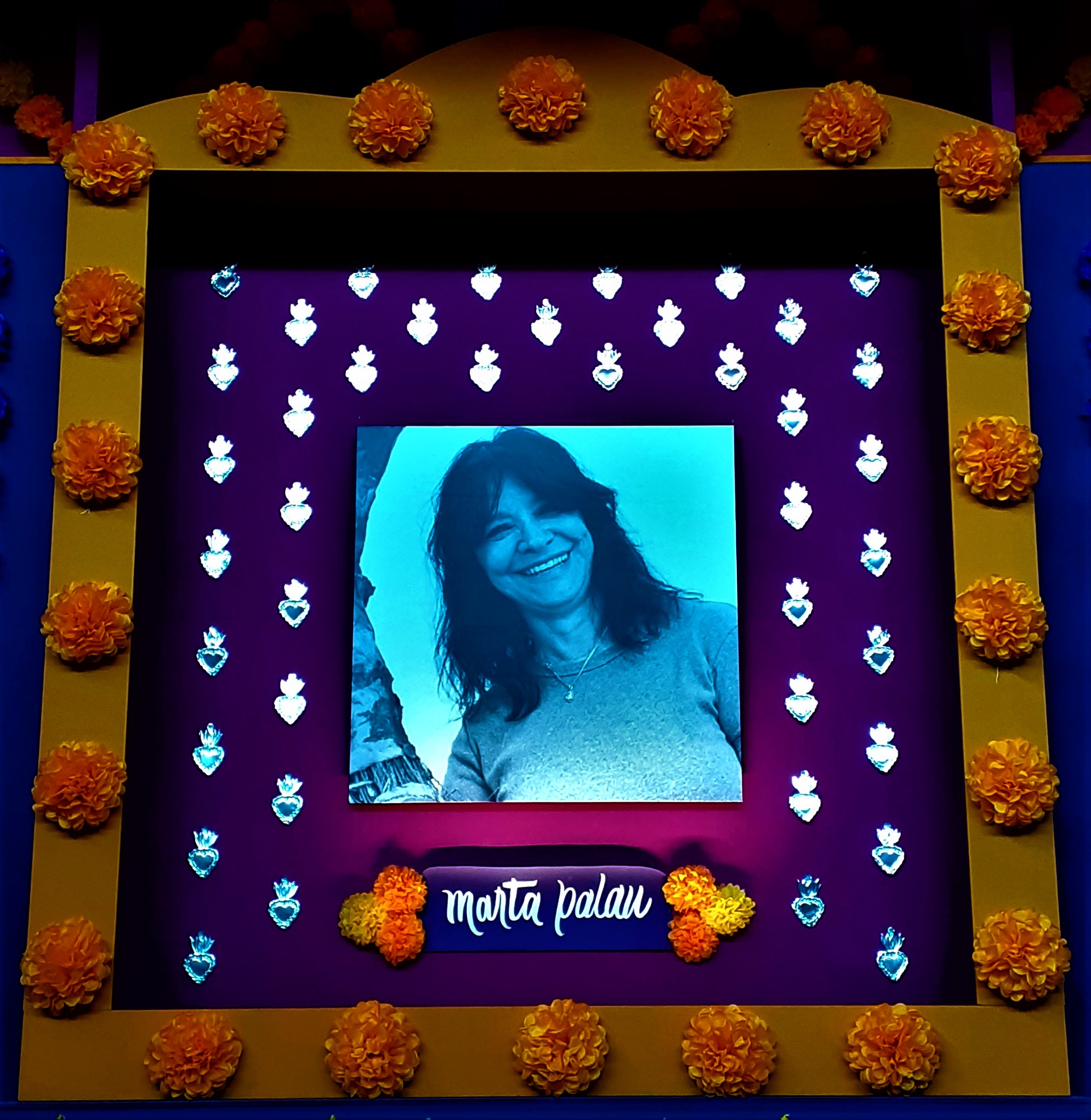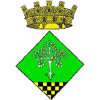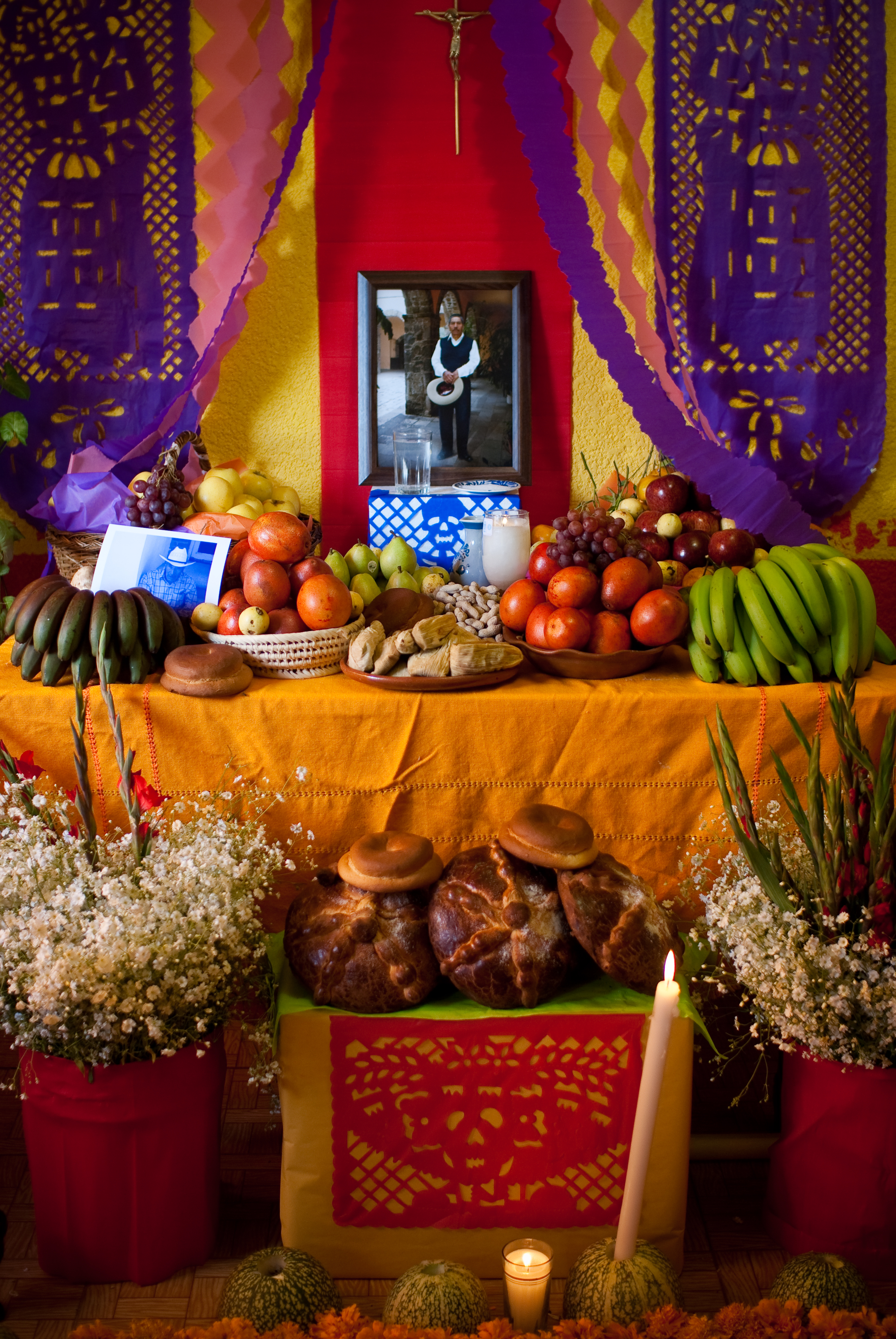|
Marta Palau Bosch
Marta Palau Bosch (17 July 1934 – 13 August 2022) was a Spanish-Mexican artist who resided in Mexico. She worked in engraving, painting, sculpture, and most prominently in tapestries, defining herself by her profound artistic use and arrangement of native Mexican natural materials. She was one of the first Mexican artists to focus on themes around women's and immigrants' experiences during the 1970s, especially in her Ilerda series of tapestries and later with her Nahual sculptures. Early life Marta Palau Bosch was born on 17 July 1934 in Albesa, Spain. As her parents were exiled during the era of Francoist Spain, the family moved to Mexico in 1940. From 1955 to 1965 she studied at " La Esmeralda", the school of painting and sculpture for the Instituto Nacional de Bellas Artes (INBA) in Mexico City. Her engraving professor at the Institute was the Colombian engraver Guillermo Silva Santamaría. She traveled to California and Barcelona in order to specialize in tapestry techni ... [...More Info...] [...Related Items...] OR: [Wikipedia] [Google] [Baidu] |
Albesa
Albesa is a municipality in the ''comarca'' of Noguera, in the province of Lleida, Catalonia, Spain. In 1003 it was the seat of the battle of Albesa. The economy is mostly based on agriculture (fruit, potato, tomato), taking advantage of the presence of an acequia. Sights include the parish church of St. Mary (18th century), with a 14th-century retablo A retablo is a devotional painting, especially a small popular or folk art one using iconography derived from traditional Catholic church art. More generally ''retablo'' is also the Spanish term for a retable or reredos above an altar, whether ..., and the remains of the ancient castle (conquered by the Christians in 1098) and of several ancient Roman villas. Notable natives * Ignasi Segarra i Banyeres, priest of Opus Dei prelature. * Fermí Palau i Casellas, teacher, politician and poet. References External links * Government data pages Municipalities in Noguera (comarca) Populated places in Noguera (comarca)< ... [...More Info...] [...Related Items...] OR: [Wikipedia] [Google] [Baidu] |
Ofrenda Marta Palau
An ''ofrenda'' (Spanish: " offering") is the offering placed in a home altar during the annual and traditionally Mexican ''Día de los Muertos'' celebration. An ''ofrenda'', which may be quite large and elaborate, is usually created by the family members of a person who has died and is intended to welcome the deceased to the altar setting. __TOC__ Background This display coincides with the Día de Muertos, which is a tradition some believe originated with the Aztecs, though others dispute this. The Aztec culture considered souls to continuously live and enter different realms when a body would die. This view the Aztecs held was commingled with the Christian beliefs that the soul is eternal (whether it be in heaven, purgatory, or hell) during the Spanish conquest of the Aztec Empire when the two cultures were merged. The ofrenda is presented in one's home in order to commemorate the souls of loved ones in the family. Components of the offering A common format for an '' ... [...More Info...] [...Related Items...] OR: [Wikipedia] [Google] [Baidu] |
Lázaro Cárdenas Del Río
Lázaro is a Spanish or Portuguese-based given name or surname. Notable people with the name include: Given name *Lázaro (footballer, born 1990), full name Lázaro Vinícius Alves Martins, Brazilian footballer * Lázaro (footballer, born 2002), full name Lázaro Vinícius Marques, Brazilian footballer *Lázaro Álvarez, Cuban boxer *Lázaro Báez, Argentine entrepreneur *Lázaro Barbosa de Sousa, Brazilian serial killer and family annihilator * Lázaro Betancourt, Cuban triple jumper *Lázaro Blanco, Mexican photographer *Lázaro Borges, Cuban pole vaulter * Lázaro Botelho, Brazilian politician *Lázaro Bruzón, Cuban chess player *Lázaro Darcourt, Cuban footballer * Lázaro Francisco, Filipino novelist * Lázaro Garza Ayala, Mexican politician * Lázaro Macapagal, Filipino colonel *Lázaro Medina, Cuban pitcher *Lázaro Navarro, Cuban tennis player * Lázaro Oliveira, Angolan footballer *Lázaro Ramos, Brazilian actor * Lázaro Ruiz, Cuban weightlifter *Lázaro Reinoso, Cuban wre ... [...More Info...] [...Related Items...] OR: [Wikipedia] [Google] [Baidu] |
Havana
Havana (; Spanish: ''La Habana'' ) is the capital and largest city of Cuba. The heart of the La Habana Province, Havana is the country's main port and commercial center.Cuba ''''. . The city has a population of 2.3million inhabitants, and it spans a total of – making it the largest city by area, the most populous city, and the [...More Info...] [...Related Items...] OR: [Wikipedia] [Google] [Baidu] |
Jalisco
Jalisco (, , ; Nahuatl: Xalixco), officially the Free and Sovereign State of Jalisco ( es, Estado Libre y Soberano de Jalisco ; Nahuatl: Tlahtohcayotl Xalixco), is one of the 31 states which, along with Mexico City, comprise the 32 Federal Entities of Mexico. It is located in Western Mexico and is bordered by six states, which are Nayarit, Zacatecas, Aguascalientes, Guanajuato, Michoacán, and Colima. Jalisco is divided into 125 municipalities, and its capital and largest city is Guadalajara. Jalisco is one of the most economically and culturally important states in Mexico, owing to its natural resources as well as its long history and culture. Many of the characteristic traits of Mexican culture, particularly outside Mexico City, are originally from Jalisco, such as mariachi, ranchera music, birria, tequila, jaripeo, etc., hence the state's motto: "Jalisco es México." Economically, it is ranked third in the country, with industries centered in the Guadalajara metropolit ... [...More Info...] [...Related Items...] OR: [Wikipedia] [Google] [Baidu] |
Guadalajara (Jalisco)
Guadalajara ( , ) is a metropolis in western Mexico and the capital of the state of Jalisco. According to the 2020 census, the city has a population of 1,385,629 people, making it the 7th largest city by population in Mexico, while the Guadalajara metropolitan area has a population of 5,268,642 people, making it the third-largest metropolitan area in the country and the twentieth largest metropolitan area in the Americas Guadalajara has the second-highest population density in Mexico, with over 10,361 people per square kilometer. Within Mexico, Guadalajara is a center of business, arts and culture, technology and tourism; as well as the economic center of the Bajío region. It usually ranks among the 100 most productive and globally competitive cities in the world. It is home to numerous landmarks, including Guadalajara Cathedral, the Teatro Degollado, the Templo Expiatorio, the UNESCO World Heritage site Hospicio Cabañas, and the San Juan de Dios Market—the largest indoor ... [...More Info...] [...Related Items...] OR: [Wikipedia] [Google] [Baidu] |
Brian Nissen (artist)
Brian Nissen (20 October 1927 in London – 8 February 2001 in Salisbury, Wiltshire) was a British actor and television continuity announcer. Biography Nissen made an early appearance in Laurence Olivier's film of Shakespeare's ''Henry V'', and made many TV, film and stage appearances, including '' The Dam Busters'' (1955), and the television series '' The New Adventures of Charlie Chan'' and ''Sword of Freedom'' in 1957. But he is probably best-remembered as an in-vision announcer for Southern Television, where his formal style seemed to sum up the company's aesthetic. He joined Southern at its inception in 1958 and stayed until its demise in 1981, and was kept on by the successor company TVS despite its general policy of breaking with Southern's conservatism. He retired from TVS in August 1987. Nissen died on 8 February 2001 in Salisbury, Wiltshire at the age of 73. Selected filmography * '' The Day Will Dawn'' (1942) - Page (uncredited) * ''The Demi-Paradise'' (1943) - Geor ... [...More Info...] [...Related Items...] OR: [Wikipedia] [Google] [Baidu] |
Fernando Garcia Ponce
Fernando Garcia Ponce (1933–1987) was a Mexican architect and abstract artist who belonged to the Generación de la Ruptura. García Ponce is best known for his abstract paintings and collages, most of which utilize structured and geometric forms rather than organic shapes. Life García Ponce was born in Mérida, Yucatán, Mexico on August 25, 1933, to Juan García Rodes, immigrant from Spain, and María "Monina" Ponce G. Cantón, a member of the so-called "casta divina" of Yucatán. At the age of 11, García Ponce's family moved to Mexico City. In 1952, García Ponce enrolled at the National Autonomous University of Mexico to study architecture. In 1967, García Ponce met the French Canadian actress Denise Brosseau, who had previously been married to Alejandro Jodorowsky. Brosseau and García Ponce married and had one child, Esteban García Brosseau. On July 11, 1987, García Ponce died of a heart attack in Coyoacán, Mexico City; García Ponce was 53 at the time. His el ... [...More Info...] [...Related Items...] OR: [Wikipedia] [Google] [Baidu] |
Vicente Rojo Almazán
Vicente Rojo Almazán (15 March 1932 – 17 March 2021) was a Spanish-Mexican painter, graphic designer, and sculptor. His daughter, Alba Rojo Cama (1961–2016), also became an artist, known for her mathematical sculpture. See also * ''País de volcanes ''País de volcanes'' () is an outdoor fountain and sculpture by the Spanish-born Mexican artist Vicente Rojo Almazán, installed outside Mexico City's Secretariat of Foreign Affairs Building and next to the Memory and Tolerance Museum, in Mex ...'' References 1932 births 2021 deaths Mexican painters Mexican graphic designers Mexican sculptors Male sculptors Place of birth missing {{Mexico-painter-stub ... [...More Info...] [...Related Items...] OR: [Wikipedia] [Google] [Baidu] |
Manuel Felguérez
Manuel Felguérez Barra (December 12, 1928June 8, 2020) was a Mexican abstract artist, part of the Generación de la Ruptura that broke with the muralist movement of Diego Rivera and others in the mid 20th century. Early life Felguérez was born in the state of Zacatecas in 1928, but political instability caused his family to lose their land there and move to Mexico City. In 1947, he had the chance to travel to Europe and, impressed with the art there, decided to dedicate himself to the vocation. Unhappy with the education at the Academy of San Carlos in Mexico, he did most of his studies in France, where he specialized in abstract art, something that was not accepted in Mexico at the time. His exhibitions were initially limited to galleries and the production of "sculpted murals" using materials such as scrap metals, stones, and sand. As attitudes in Mexico changed towards art, Felguérez found acceptance for his work and remained active at over eighty years of age. Manuel F ... [...More Info...] [...Related Items...] OR: [Wikipedia] [Google] [Baidu] |
Gilberto Aceves Navarro
Gilberto Aceves Navarro (September 24, 1931 – October 21, 2019) was a Mexican painter and sculptor and a professor at the Escuela Nacional de Artes Plásticas and Academy of San Carlos. There have been more than two hundred individual exhibits of his work, with his murals found in Mexico, Japan and the United States. He received numerous awards for his work including grants as a Creador Artístico of the Sistema Nacional de Creadores de Arte, Premio Nacional de Ciencias y Artes and Bellas Artes Medal from the Instituto Nacional de Bellas Artes. Life Gilberto Aceves Navarro was born on September 24, 1931 in Mexico City, to María Francisco de los Angeles Navarro and Juan Aceves Jacques, the youngest of three children. His mother was an opera singer who read tarot cards and practiced other kinds of magical arts. His father was a failed singer who abandoned the family for the best friend of his mother. His mother became pregnant with him to try and bring the father back but it ... [...More Info...] [...Related Items...] OR: [Wikipedia] [Google] [Baidu] |
Lilia Carrillo
Lilia Carrillo García (2 November 1930 – 6 June 1974) was a Mexican painter from the Generación de la Ruptura, which broke with the Mexican School of Painting of the early 20th century. She was trained in the traditional style but her work began to evolve away from it after studying in Paris in the 1950s. While she and husband abstract artist Manuel Felguérez struggled to get their work accepted, even selling Mexican handcrafts and folk art to survive, she eventually had her canvas work exhibited at large venues in Mexico City and various cities in the world. Her work was part of the inaugural exhibition of the Museo de Arte Moderno in Mexico City in 1964. After her death in 1974, her work received honors from the Palacio de Bellas Artes and has been exhibited in various venues. Life Lilia Carrillo was born on November 2, 1930 to General Francisco Carrillo, a pilot, and Socorro García, their only child. The father abandoned the family when Lilia was young and her mother ra ... [...More Info...] [...Related Items...] OR: [Wikipedia] [Google] [Baidu] |




.jpg)
